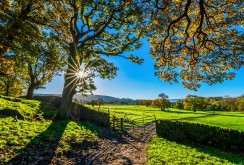
Doug Tompkins, the founder of the clothing company Esprit, once said that “If anything can save the world, I’d put my money on beauty.” I concur. Tompkins wasn’t talking about L’Oreal’s #beautyforall branding. He was talking about the beauty of our landscapes, towns and cities.
I believe people flourish in beautiful surroundings and that all Americans have a right to live, work and play in beautiful places. Beauty is an essential part of the good life, a natural aspect of the “pursuit of happiness,” and, according to psychologist Abraham Maslow, a universal human need.
Evidence shows that all Americans appreciate beauty, regardless of their political views, origin, or creed, and that working to restore beautiful landscapes and create beautiful places can bring us together and build community in polarizing times.
No matter who we are, we are inspired by the majesty of our national parks and the beauty of well-tended landscapes, clear lakes and streams, graceful buildings and inviting public spaces. We are uninspired and unhappy among denuded landscapes, polluted waters, scarred mountainsides, littered streets, strip malls and commercial clutter, derelict buildings and cold uniform living spaces like the bland gray apartments of the Soviet era or the failed grim housing projects in our own cities.
We honor those who have democratized our grandest natural wonders and passed on to us a legacy of attractive buildings, parks and green spaces to work and play in. We should also recognize the inequalities still inherent in our access to beauty and seek to extend opportunities to experience beauty to all who share this country.
Yet in the quest for wealth and growth we have overlooked the human need for beauty. We’ve allowed the mountaintops of Appalachia to be turned into ugly strip mines, and justified their desecration in the name of energy and jobs. We have allowed our best soils to drift, with the chemical fertilizers and toxic pesticides let loose on them by corporate agribusiness, down the Mississippi, creating a vast “dead zone’ at its outlet in the Gulf of Mexico. We’ve done this for a long time, but we tried to stop it once.
Half a century ago, during the presidency of Lyndon Baines Johnson, America made a national commitment to natural beauty and conservation. From a series of task forces to a cabinet-level bureau and White House conferences on Natural Beauty and Conservation, we set forth to reduce pollution, banish litter, beautify our cities and countryside and restore broken landscapes. “Those who would not live without beauty must join in a tireless effort to bring it into being,” President Johnson declared.
Led by the president’s wife, Lady Bird Johnson, we pledged to beautify America. We established beautification committees in many states and cities, and brought together diverse Americans of multiple professions to use their skills to make our country more beautiful.
We passed more conservation legislation than ever before in our history, including protection for Wilderness and Wild and Scenic Rivers. We banished billboards and auto junkyards from our interstate system and reduced their presence on other thoroughfares. We passed clean air and water legislation. We stood for bold new ideas like burying powerlines to increase the aesthetic values in our cities.
We revitalized our nation’s capitol, long an embarrassment for foreign visitors, beginning with the poorest sections of the city. We committed ourselves to increasing parklands and green space. We talked of a national program of bikeways and pathways connecting our cities and offering new recreational opportunities. We called for an educational commitment to understand ecology and the necessity of conservation. We called for shifting agricultural subsidies to support small and sustainable farming operations.
Stirred by such commitments and by an upsurge of new organizations like the Sierra Club (with its stunning coffee-table volumes celebrating the American earth), millions of us, from Scout troops to garden clubs, from architects to wildlife managers, from artists and musicians to ordinary citizens of all varieties, were drawn by the dream of beauty and found ways to do our parts.
Exactly 50 years ago, President Johnson declared 1967 “The Year of Youth for Natural Beauty and Conservation,” and youth responded, planting millions of trees, cleaning up tons of waste and, eventually, organizing the great Earth Day event in 1970, when 20 million Americans protested environmental degradation and demanded a new era of protection.
It was a time of optimism, when we believed in our government and in each other, when we truly believed that progress in quality of life and spiritual growth need not be sacrificed to utilitarian economic goals.
We didn’t get all we sought and the Vietnam War intervened to reduce both our trust in government and the resources we could commit to beautify our land. But we started. Now is time to build on that legacy and complete the mission.
With several colleagues, I am organizing a new campaign, And Beauty for All, to finish what Johnson began. We advocate:
- A CPR campaign for the Earth—
--Conservation of soil, water, biodiversity, wildlife
--Preservation of natural areas, greenspace, parks, wildness
--Restoration of natural landscapes, soil, fisheries
- Revitalized rural communities and small farms
- Sustainable agriculture, including urban farms
- Cooperative economic development and support for small business
- Human-friendly urban and suburban redesign
- Reduction of sprawl
- Rural resettlement to reverse the rush to cities and the hollowing out of our small towns
- Training young people to be sustainable, small-scale farmers and gardeners
- National service in restoration and conservation, including a large-scale campaign to restore the mountaintops of Appalachia
- Public sector jobs in restoration and conservation
- Partnerships with land grant universities and institutes
- A focus on re-localization
- A national rails-to-trails system
- Additional hike- and bikeways with affordable campgrounds
- Improving the beauty of our cities by burying powerlines underground
- New regulations on strip mall development and outdoor advertising
- Support for artists to help beautify urban areas
- A priority for our poorest and least-served communities
- New research centers to support the program
- Making “America the Beautiful” our National Anthem.
“Beauty feeds a different kind of hunger,” writes Terry Tempest Williams. “Beauty is not optional, but a strategy for survival…Finding beauty in a broken world is acknowledging that beauty leads us to our deepest and highest selves. It inspires us. We have an innate desire for grace.” If you’d like to join this campaign, write me at: jodg@comcast.net.
John De Graaf is a writer, filmmaker, and author. Since 1977, he has produced more than 40 documentaries, and dozens of shorter news stories and films. He has written dozens of articles for such publications as The Progressive, The Nation, The New York Times and many others. He is the author or co-author of four books, including Affluenza, which is an international best-seller.










